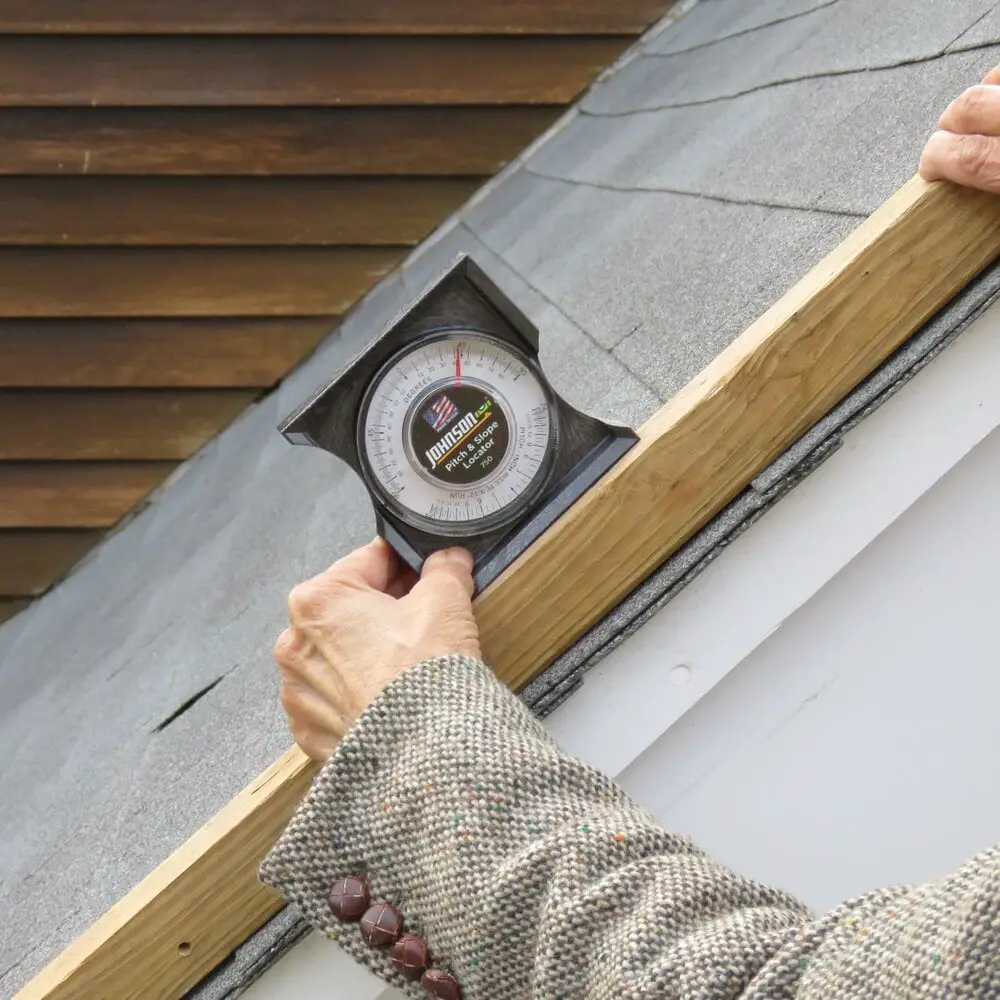Roof Pitch Multiplier Calculator, Table & Guide
By Jack Gray, Roof Online Editor • Updated November 20, 2023
Table of Contents
- What is a Roof Pitch Multiplier?
- Use Standard Pitch to Find the Multiplier
- Roof Pitch Multiplier Formula
- Roof Pitch Multiplier Calculator
- Note on Proper Format When Stating Roof Pitch
- Using the Pitch Multiplier for Common Rafters
- Notes
- Roof Pitch Multiplier Chart
- Related Pages

What is a Roof Pitch Multiplier?
A roof pitch multiplier, also called a roof pitch factor, is a number that you use to find the actual surface area of a pitched roof or the length of a common rafter.
You multiply the roof pitch multiplier by the area, or footprint, covered by a sloped roof to find the actual surface area of the roof.
You can also multiply the roof pitch multiplier by the run (length of the horizontal distance covered) of a common rafter to find its actual length.
Use Standard Pitch to Find the Multiplier
You will need to know the slope of your roof in the standard pitch format “X-in-12″ for the rest of this page to make sense.
For help converting from degrees or percentage to traditional pitch, see our pages Roof Slope Equivalents or Roof Pitch to Degrees • Degrees to Roof Pitch.
Roof Pitch Multiplier Formula
Once you know your roof slope expressed as “X-in-12″ (rise-in-run), the roof pitch multiplier is determined by finding the square root of ((rise/run)² + 1).
Remember that the slope of the roof provides the rise and the run to be plugged into the equation. A roof pitch of 4-in-12 (4:12) has a rise of 4 and a run of 12.
So you divide the rise by the run (the run is always 12 and the rise depends on your particular roof).
Square the result.
Add 1.
Find the square root of the result.
There’s a good general scientific calculator online here if you want to do the math.
Roof Pitch Multiplier Calculator
You can use this roof pitch multiplier calculator to find the multiplier for any roof pitch, including pitches that have decimal fractions. Multipliers are calculated to three decimals.
Roof Pitch Multiplier Calculator
Note on Proper Format When Stating Roof Pitch
When you talk about roof pitch, the correct way to say a specific pitch is to use the format “X-in-12”, so if you’re talking about a roof that rises 7 units for every 12 units it runs horizontally, you would say that the roof has a 7 in 12 pitch.
In roofing industry literature, the standard abbreviation used for indicating a particular roof pitch has a colon and takes the form “X:12” or “X : 12”, so for a 7 in 12 pitch, you would write “7:12 pitch”.
As a practical matter, it seems like almost everyone searching for information about roof pitch on the internet is searching for a roof pitch using a slash, as in “7/12”. In order to help more people find what they’re looking for, we are using the “X/12” form in our roof pitch multiplier table below.
Using the Pitch Multiplier for Common Rafters
The roof pitch multiplier is used to calculate the length of common rafters.
To find the length of a common rafter, determine its span from the bottom of the end of the rafter tail to the top of the ridge cut at the ridge board. Once you know the actual horizontal distance it will cover, use the formula above.
Multiply the roof pitch multiplier by the run of the rafter (the horizontal distance covered by the rafter). That will give you the proper rafter length.
To find the location of the heel cut, the multiplier is multiplied by the “effective run” of the rafter. The effective run is the horizontal distance covered by the rafter from the near side of the ridge board, where the head cut will be, to the outside of the wall plate, where the heel cut will be.
Always measure for every rafter, even being off ⅛-inch can make a big difference if the error gets multiplied as you go along.
Notes
1. The following table provides the roof pitch multiplier for roofs of various slopes. For a more detailed explanation of the roof pitch multiplier, see “How to Find the Area of a Sloped Roof“.
2. If you know the roof pitch in degrees, find the secant of the slope using a scientific calculator. (You can use this free online scientific calculator.) For example, if the roof pitch is 45°, then sec(45) = 1.414213. That’s your roof pitch multiplier.
3. If you’re not sure what the pitch of your roof is and you want to figure that out, we recommend this slope finder on Amazon. It’s very inexpensive and very accurate.
If you want to know the slope of anything to an amazing degree of accuracy and you like cool new tools, you should check out this digital level.
It may be way too expensive for what you need, but this is what professionals use. It will tell you the slope of your roof in degrees, rise/run, or percentage, and automatically convert from one to the other.
4. One more thing: if you’re using this table, you should consider getting yourself a construction calculator. This one is very good.
Roof Pitch Multiplier Chart
| Roof Pitch Multipliers by Slope | ||
|---|---|---|
| Roof Slope (Rise-in-Run) |
Roof Slope (In Degrees) |
Roof Pitch Multiplier |
| 0.5-in-12 | 2.39° | 1.001 |
| 1/12 | 4.76° | 1.003 |
| 1.5/12 | 7.13° | 1.008 |
| 2/12 | 9.46° | 1.014 |
| 2.5/12 | 11.77° | 1.021 |
| 3/12 | 14.04° | 1.031 |
| 3.5/12 | 16.26° | 1.042 |
| 4/12 | 18.43° | 1.054 |
| 4.5/12 | 20.56° | 1.068 |
| 5/12 | 22.62° | 1.083 |
| 5.5/12 | 24.62° | 1.100 |
| 6/12 | 26.57° | 1.118 |
| 6.5/12 | 28.44° | 1.137 |
| 7/12 | 30.26° | 1.158 |
| 7.5/12 | 32.01° | 1.179 |
| 8/12 | 33.69° | 1.202 |
| 8.5/12 | 35.31° | 1.225 |
| 9/12 | 36.87° | 1.250 |
| 9.5/12 | 38.37° | 1.275 |
| 10/12 | 39.81° | 1.302 |
| 10.5/12 | 41.19° | 1.329 |
| 11/12 | 42.51° | 1.357 |
| 11.5/12 | 43.78° | 1.385 |
| 12/12 | 45° | 1.414 |
| 12.5/12 | 46.17° | 1.444 |
| 13/12 | 47.29° | 1.474 |
| 13.5/12 | 48.37° | 1.505 |
| 14/12 | 49.4° | 1.537 |
| 14.5/12 | 50.39° | 1.568 |
| 15/12 | 51.34° | 1.601 |
| 15.5/12 | 52.25° | 1.634 |
| 16/12 | 53.13° | 1.667 |
| 16.5/12 | 53.97° | 1.700 |
| 17/12 | 54.78° | 1.734 |
| 17.5/12 | 55.56° | 1.768 |
| 18/12 | 56.31° | 1.803 |
| 18.5/12 | 57.03° | 1.838 |
| 19/12 | 57.72° | 1.873 |
| 19.5/12 | 58.39° | 1.908 |
| 20/12 | 59.04° | 1.944 |
| 20.5/12 | 59.66° | 1.979 |
| 21/12 | 60.26° | 2.016 |
| 21.5/12 | 60.83° | 2.052 |
| 22/12 | 61.39° | 2.088 |
| 22.5/12 | 61.93° | 2.125 |
| 23/12 | 62.45° | 2.162 |
| 23.5/12 | 62.95° | 2.199 |
| 24/12 | 63.43° | 2.236 |
| 24.5/12 | 63.90° | 2.273 |
| 25/12 | 64.36° | 2.311 |
| 25.5/12 | 64.80° | 2.349 |
| 26/12 | 65.22° | 2.386 |
| 26.5/12 | 65.64° | 2.424 |
| 27/12 | 66.04° | 2.462 |
| 27.5/12 | 66.43° | 2.500 |
| 28/12 | 66.80° | 2.539 |
| 28.5/12 | 67.17° | 2.577 |
| 29/12 | 67.52° | 2.615 |
| 29.5/12 | 67.86° | 2.654 |
| 30/12 | 68.20° | 2.693 |
| 30.5/12 | 68.52° | 2.731 |
About the Author
Jack Gray is a principal roof consultant and vice president at the Moriarty Corporation, an award-winning building enclosure consultant firm founded in 1967. He is also the editor of the Roof Online website.

Mr. Gray has worked in the roofing industry for over 25 years, with training and practical experience in roof installation, roof inspection, roof safety, roof condition assessment, construction estimating, roof design & specification, quality assurance, roof maintenance & repair, and roof asset management.
He was awarded the Registered Roof Observer (RRO) professional credential in 2009.
He also served as an infantry paratrooper in the 82nd Airborne Division and has a B.A. from Cornell University. Read full bio.